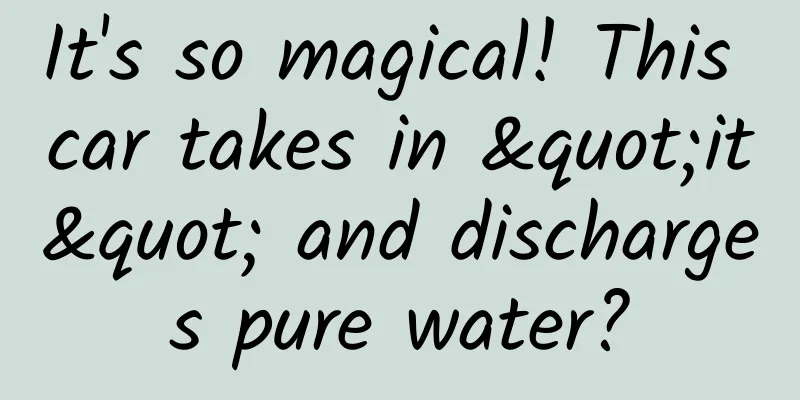It's so magical! This car takes in "it" and discharges pure water?

|
Expert of this article: Qi Liya, PhD from Peking University, visiting scholar at Harvard University Recently, at the opening ceremony of the Winter Olympics, everyone must have been impressed by the lighting of the torch. This advanced lighting is the ultimate romance of the Chinese people. But do you know that it looks like just a small torch, but there is actually a lot of "black technology" hidden behind it? Unlike previous Olympic Games that used large amounts of liquefied natural gas or propane gas as torch fuel, the torch for this Winter Olympics burned hydrogen energy, achieving zero carbon emissions for the first time in the history of the Winter Olympics. Whether it is the torch that lights the Olympic flame at the opening ceremony or the more than 1,100 buses that shuttle around the Olympic competition area, "hydrogen energy" is used to great effect. What is hydrogen energy? Why is it used in torches? Why can it also be used in cars? Let's learn about it together today. Why does the Winter Olympics torch use hydrogen energy? Hydrogen energy is essentially a kind of energy that provides various energies for our lives. From this point of view, the role of hydrogen energy is the same as that of common traditional energy sources in life, such as gasoline and natural gas. It is known as the "green energy of the 21st century" because of its cleanliness and efficiency. The three main characteristics of hydrogen energy are high energy density, wide sources, and clean and low-carbon. Under the same ideal conditions, taking coal as an example, the energy released by 1 kg of hydrogen is about 5 times that of 1 kg of coal; at the same time, hydrogen energy has a wide range of sources. It can be obtained through the reforming of fossil energy such as coal, oil, and natural gas, or industrial by-product gas, or it can be directly produced through water electrolysis; hydrogen energy is a clean and low-carbon energy source. Its final combustion product is water, and it will not produce a large amount of pollutants and greenhouse gases like traditional energy. Therefore, the Beijing Winter Olympics torch chose hydrogen energy not only because hydrogen fuel itself can continue to burn at low temperatures, but also because hydrogen energy is clean and has zero emissions when burned. In addition, regarding the color of the Winter Olympics torch flame, hydrogen burns in the air to produce a light blue flame, which is almost invisible to the naked eye in the natural environment. For this reason, researchers developed dozens of flame colors and finally determined a yellowish color. In addition to the torch, hydrogen energy has also been widely used on Winter Olympics buses. Fuel cell vehicles, one of the representatives of new energy vehicles, use hydrogen energy as power. What are the advantages of hydrogen cars compared to pure electric cars? A hydrogen fuel cell vehicle is a vehicle powered by hydrogen fuel cells. The chemical reaction between hydrogen and oxygen will generate a large amount of energy, thus providing a continuous source of power for the vehicle. Compared with traditional cars, hydrogen fuel cell vehicles have a short refueling time, high energy density, and their emissions are water, which can truly achieve zero pollution and zero carbon emissions. News screenshots A hydrogen fuel cell vehicle refers to a vehicle powered by hydrogen fuel cells, and a pure electric vehicle refers to a vehicle powered by lithium-ion batteries. There are significant differences between the two in terms of on-board batteries, cost, performance, etc. From the perspective of batteries, hydrogen fuel cells are essentially power generation devices. Once the car runs out of power, hydrogen can be added to generate power and replenish energy for the car at any time, which is similar to adding gasoline to a car. Lithium batteries are energy storage devices. The amount of energy in the battery pack directly determines how far the car can run. Once the battery pack runs out of power, it takes some time to store the power back in the battery pack. Therefore, hydrogen fuel cell vehicles charge faster and run farther than pure electric vehicles. From the perspective of automobile cost, lithium batteries are relatively simple, the technology is relatively mature, and large-scale production has been achieved, with low costs; while fuel cell vehicles are more difficult to use, key materials still rely on imports, and the cost of hydrogen refueling stations is much higher than that of lithium battery charging stations. Therefore, pure electric vehicles have a greater advantage in terms of cost. Staff are refueling vehicles with hydrogen. Source: Beijing 2022 Winter Olympic and Paralympic Organizing Committee website In terms of environmental protection, both hydrogen fuel cell vehicles and pure electric vehicles are environmentally friendly and low-carbon emissions. The emission of hydrogen fuel cell vehicles is water. Compared with pure electric vehicles that are prone to environmental pollution due to improper battery electrolyte handling, hydrogen fuel cell vehicles are more green and environmentally friendly. In other aspects, hydrogen fuel cell vehicles need to carry high-pressure gas cylinders when driving, which can easily cause hydrogen leakage during collisions and hydrogen refueling, posing greater safety risks. At low temperatures, the electrolyte performance of pure electric vehicle batteries decreases and the internal resistance of the battery increases. At low temperatures, hydrogen fuel cell vehicles perform better than pure electric vehicles. Overall, hydrogen fuel cell vehicles and pure electric vehicles each have their own advantages and disadvantages, and the two basically show a trend of complementarity and common development. What other application areas does hydrogen energy have? Hydrogen energy is not widely used in life due to its inherent safety and the difficulty of storage and transportation. In addition to the hydrogen-powered cars we are familiar with, hydrogen energy is mainly used in some small-scale civilian and commercial energy supply systems in daily life, such as small-scale civilian fuel cell power stations, small-scale commercial fuel cell power stations, fuel cell drones, etc. I believe that with the continuous advancement of science and technology, hydrogen energy technology will become more and more mature, bringing more and more clean help to our lives! The pictures in this article with the "Science Popularization China" watermark are all from the copyright gallery. The pictures are not authorized for reprinting. |
<<: Rare! The explosive "blue tears" shocked the screen! What are "blue tears"?
Recommend
A wonderful phenomenon in nature: the “creator” of the “clear distinction” is actually this!
The idiom "荆魏分明" comes from "The B...
Microsoft's win10 and its black technology
Editor's note: Can the release of Windows 10 ...
Negative comments about its products continued, and the price fluctuations scared consumers. Tesla's domestic sales plummeted by 60%
Tesla has been in the news recently, but there is...
Analysis of mobile phone camera sensors
We all know that the most important part of determ...
Türkiye discovered nearly 700 million tons of rare earths. Are China’s “trump card” rare earths no longer attractive?
Türkiye's discovery of nearly 700 million ton...
Weibo released its 2019 annual financial report, with annual financial revenue reaching 12.24 billion yuan
Recently, Weibo released its full-year and fourth...
One article will help you learn Ogilvy's social marketing strategy framework!
▎Social Marketing Trends Integrated social soluti...
Homemade pickles, raw pickled seafood, etc. are healthy and delicious? Homemade food has risks
Author: Wang Lu, Chinese registered dietitian, Ma...
It has gone through a lot of hardships and traveled 8 billion light years to see you
Fast radio bursts (FRBs) are mysterious radio ast...
Excessive calcium supplementation is harmful! Many people have taken calcium supplements incorrectly over the years
Is the TV cabinet of your elderly also piled with...
It doesn’t matter if you don’t have enough budget. We will teach you how to promote for free on a platform with 700 million users.
We all know that how many people can be promoted ...
Ziyang Mini Program Investment Company, how much does the paper product mini program cost?
What is the investment cost of Ziyang Paper Produ...
Taking the operation of WeChat public account as an example, we will teach you how to find user growth points!
Every business and operations team is pursuing us...
What signals appear in your body indicate that your heart is asking you for help?
Reviewer of this article: Chen Haixu, Deputy Dire...
Meituan’s O2O dilemma: eliminating group buying, reducing costs, and relying on giants
It has to be said that Wang Xing has an extremely...









